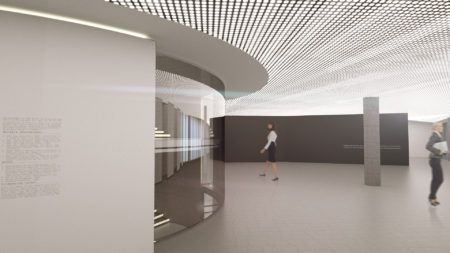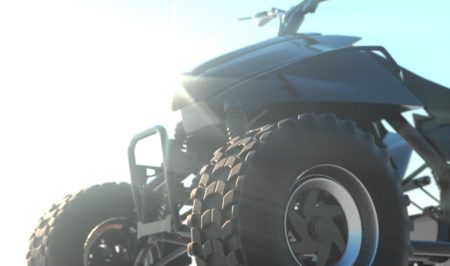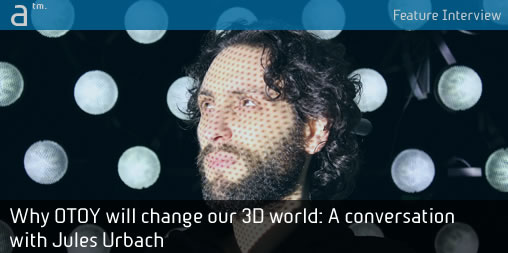Continued from page 1
Move Over OpenGL and DirectX—Meet the New “Brigade”
AFR: So tell me about Brigade. What is it?
JU: OTOY is starting to focus on the bigger eco-system and Brigade is one of those pieces. Brigade is going back to my desire to see cloud gaming being taken to the next level. I think there is definitely something to be said for just putting a game in the cloud, and not have to worry about the hardware; but we think that if you are going to game on the cloud you have to offer people way more GPU power—an order of magnitude more than they get on their device. And of course that is becoming more challenging now where you actually have the integrated graphics which are becoming pretty good. We now have OpenGL ES 3.1 on phones where we have compute shaders, right? So today Brigade takes it to the next level providing Octane-level realism with enough shortcuts to make 50 hz game play viable.
Advertisement
And with Amazon providing so many GPUs and doing that worldwide, we can actually launch a cloud gaming platform around that and they have been very encouraging in that respect. OTOY has been putting all the technology pieces together for that.
So the pipeline for Brigade will be basically Octane. Octane exports this package file format, which we are open-sourcing as ORBX, which can be video like we see in streaming online today plus contain all the data used to render in Octane. So Brigade can consume that and then you basically have a ready to go, physically correct rendering pipeline, for cloud gaming. And of course with the Octane ecosystem touching just about every 3D app out there—and now getting into 2D apps like After Effects (AE) and Photoshop—the idea is you should be able to export and import an ORBX file as simply as you do a JPEG. And that’s what we are trying to accomplish with the interchange format.
AFR: And do the two feed each other?
JU: There is definitely some cross-pollination between Octane and Brigade. Some of the things that made Octane better came from the research that went into Brigade.
AFR: So how does Brigade work on an API level? Is it working above OpenGL and DirectX or instead of?
JU: It’s totally separate, it uses compute to do all the rendering; it doesn’t use any OpenGL or DirectX to do the 3D rendering. It’s all done in compute shaders—just like Octane is.

03 – Brigade is aimed at replacing or by-passing both OpenGL and Microsoft’s DirectX graphics API technology. It utilizes a full GPU raytracing procedure including geometry to shading—all without pixel shaders or vertex shaders. It is aimed at both online gaming and high-end visualizations, including film industry work. (image courtesy of OTOY. All rights reserved).
OpenGL and DirectX are rasterizers, you send triangles and they are rendered to the screen, back to front and all that stuff—and there’s fixed function hardware that does that stuff very quickly. However, you can’t do reflections, you can’t do physically correct light and shades so you have to fake all that with pixel shaders and vertex shaders, so Brigade is very much like Octane where it is doing the full path raytracing calculation. You get basically perfect lighting. It doesn’t have the full material system that Octane does but you end up with the speed of OpenGL or DirectX with dynamic environments and characters.
So Brigade is basically a replacement for DirectX and OpenGL. In fact, the way we see it being used is as a component in a game engine. So if we look at something like Unity or the Source Engine or Unreal, those things have multiple backends, right, so they all support various versions of DirectX, OpenGL, OpenGL ES, et cetera, and Brigade is basically just another backend target. And since some of those have physically correct materials, you just plugin into Brigade and suddenly all your games are raytraced or path traced. And you are not limited to two GPUs to do frame interleaving—you can have a whole cloud of them and do that on demand but remotely.
AFR: So Brigade is doing all the geometry too or just a part of it, in tandem with OpenGL or DirectX?
JU: No, Brigade is doing all of the geometry—direct triangle calls, et cetera. We can do total procedural shapes and things like that—that don’t use a tessellation system. We can render a perfect sphere; we can render a strand. And none of them need to be Direct drawn or OpenGL primitives, they can be completely novel, and that gives us this massive amount of flexibility.
So Brigade is a full raytracing system, geometry to shading to final output, and there is no DirectX or OpenGL in any of those parts.
It All Runs on Octane
AFR: You have a lot of plugins for so many 3D applications out there, just about everybody. Who is coming to who in these deals and arrangements? And the second part of this question is, obviously, you have a major partner in Autodesk. Can you step back and explain where you see that going in the big picture sense?
JU: I guess I’ll start talking about the first question first and then get to the second one. So with Octane we really don’t reach out to that many other companies. Some of the plugins are just in-house, like Maya, Max and Blender—those are obvious ones—some of them like Poser are being led by advanced users who ask to get the SDK, work with us to build it, and we split the revenue with them. And we do that. And they get most of the revenue and credit for doing that work. We just help them create it. And that is why we have so many plugins. We just get a reasonable minor percentage.
I think we have done every 3D app. I don’t think there is a 3D app we haven’t yet done. That’s why we are onto the 2D apps now. Anyone who makes an app that supports plugins, we are able to get an Octane render plugin done in a matter of months. We think down the road we will likely split Octane and it will become a web service. So just like you can upload or embed YouTube videos—you will be able to upload Octane renders.

04 – An architecture visualization render using Octane Render by architectural viz pro Stefan Mantu. (image courtesy OTOY. Photo credit. Stefan Mantu. All rights reserved.)
Eventually we see Octane just being available as a web service and that way others can even more easily embed it into their apps and it becomes just another service out there. I think that is the future, where you will be able to compute on demand. I think that is a big part of it. That is where the future is!
AFR: And what goes on the client…
JU: And intelligently putting some stuff on the client. I think the Web today is powerful. HTML-5 is very powerful. You look at what Famous just launched and look at how good that looks!—you have enough there to build a really good front end for any application, you really don’t need that anymore. And if you do it correctly your app will run everywhere, every phone OS and every platform.
AFR: This is adding color to the whole Autodesk thing…thanks for explaining this.
JU: I think Autodesk is looking at this very correctly. They are building out Autodesk 360 as this hub and if you look at what we just launched in November, we are just one step away from delivering Max or Maya as part of that.
What we did with Autodesk was prove the technology—that it will stream—that the apps can run in the cloud and the next version or iteration of all this will be greatly improved. That’s why we say we are probably at the mid-point of even what we are doing with Autodesk. I think the next steps are to sit down and use the technology more. We took the first steps.

05 – Another render out of Brigade. Notice the lighting quality in particular. This is the type of visualization coming to online games soon thanks for the new technology by OTOY. (image courtesy of OTOY. All rights reserved).
Now that you saw that phase done and very successfully, you will probably see that stuff adopted within Autodesk. You may find that every team at Autodesk finds a way to do the web-based version of an app that used to require a desktop piece. And I don’t think it’s going to be pure loading. I think WebGL will be done locally and only the hardest stuff will be done in the cloud. And ultimately what we are trying to build is the technology to fuel this. You will still have the UI/UX stuff being powered at the desktop, so you are not going to be viewing a simple steam, but the power of the cloud will take over the hard number crunching parts.
AFR: Those are very large and transformational changes.
JU: That’s where I think we are going. That’s where companies like Lagoa are—that are purely browser based—and I think that is really cool too . . . But the idea is that the technology we are bringing to market you can do that without any compromise and not lose any of the features that you are used to having on a high-end desktop experience. So we are always working on pushing that and part of our partnership with Mozilla is to say: this is what we really need to make these apps for Autodesk work—to really make that seamless.
So we have a nice circle of partners, with Mozilla and us and with Autodesk and its apps, I see this being the way things are going and the hardware to run this is getting simpler and the barrier to entry is falling–which is what I think people want.
To learn more about OTOY visit them on the web.






Reader Comments
http://t.co/jf8xpWzluH Architosh talks to Jules Urbach of @OTOY about his company’s GPU-based transformative technology. Read on!
#CAD Why OTOY will change our 3D world: A conversation with Jules Urbach http://t.co/cbKBpJd0qA
RT @architosh: http://t.co/jf8xpWzluH Architosh talks to Jules Urbach of @OTOY about his company’s GPU-based transformative technology. Rea…
http://t.co/jf8xpWzluH Architosh talks to Jules Urbach of @OTOY about his company’s GPU-based transformative technology. Read on!
http://t.co/jf8xpWzluH — Jules Urbach of OTOY fame talks about his company’s partnership with Autodesk. All in the interview—read on!
http://t.co/jf8xpWzluH — Jules Urbach of OTOY fame talks about his company’s partnership with Autodesk. All in the interview—read on!
#CAD Why OTOY will change our 3D world: A conversation with Jules Urbach http://t.co/cbKBpJd0qA
RT @architosh: http://t.co/jf8xpWzluH Architosh talks to Jules Urbach of @OTOY about his company’s GPU-based transformative technology. Rea…
RT @architosh: http://t.co/jf8xpWzluH Architosh talks to Jules Urbach of @OTOY about his company’s GPU-based transformative technology. Rea…
RT @architosh: http://t.co/jf8xpWzluH Architosh talks to Jules Urbach of @OTOY about his company’s GPU-based transformative technology. Rea…
RT @architosh: http://t.co/jf8xpWzluH Architosh talks to Jules Urbach of @OTOY about his company’s GPU-based transformative technology. Rea…
Why OTOY will change our 3D world: A conversation with Jules Urbach | Architosh http://t.co/pu0tfwweTd
Why OTOY will change our 3D world: A conversation with Jules Urbach | Architosh http://t.co/pu0tfwweTd
Resistance is futile. http://t.co/1ZIRZhOtaa
Resistance is futile. http://t.co/1ZIRZhOtaa
Comments are closed.